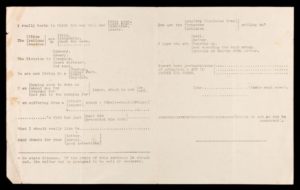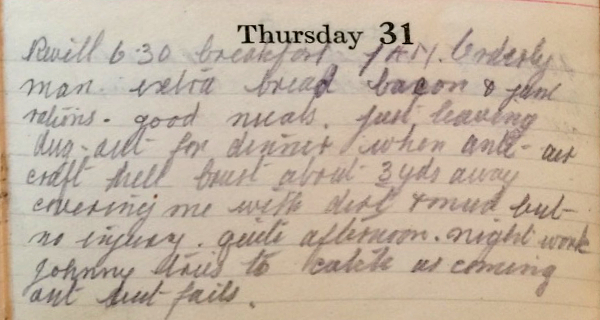Thursday Jan 31st, 1918
Reveille 6:30, breakfast 7am. Orderly man extra bread, bacon and jam rations. Good meals. Just leaving dug-out for dinner when anti-air craft shell burst about three yards away covering me with dirt and mud but no injury. Quiet afternoon. Night work – Johnny tries to catch us coming out but fails.
In the Officers’ Mess
Frank starts the morning as an orderly in the Officers’ Mess. As ever, when on such duty, his food intake goes up considerably. He happily records this bounty in his diary. Over the past few weeks, Frank has seemed more sanguine about enemy fire and the dangers of night patrols. He reports both in a rather upbeat style today.
Censorship

During WWI pretty much everything was censored by all countries. In Britain this included plays, films, newspapers and publications, and commercial and private correspondence. Photographs were no exception. At the beginning of the War, Kitchener threatened to court martial any soldier he saw with a personal-use camera.¹ Over time this attitude relaxed and some commanding officers actually authorized soldiers to take photographs for their unit. By 1916, there were official war photographers posted in various theatres of war and aerial photography was recognized to be of military importance. However there was also a concern that photographs might fall into enemy hands and presumably this is the background to the entry in today’s Battalion diary.
Every letter written home by the Tommy was read by an Officer who then had to frank the envelope before it could be posted. There were only two exceptions. In one, a letter could be placed in a green envelope, for which the soldier had to self-attest to its contents. The other was the Field Service Postcard – complete with pre-printed commentary from which the soldier could select the most appropriate and then sign and date. This led Captain Neil Cantlie to create the delightful spoof letter reproduced here.²
Summarizing the Month
The last paragraph of today’s Battalion diary is a summary of the wellbeing of the 13th and its effective strength for the month of January. It is good to know that the use of the baths and the disinfectant barrels had the desired effect!
13th (Service) Battalion War Diary – 31st January 1918 – Vladaja Camp
In the forenoon enemy placed about 10 shells mostly 4.2 about the HQ camp Vladaja – no damage was done. During the day the ADMS 22nd Div and the GOC 66th Infantry Brigade inspected the proposed site for a new Battalion HQ in Vine Ravine (Approx position coords 1275/1806). All photographs developed and printed in the Battalion have to be censored under Battalion arrangements. 7 OR having rejoined are again taken on the strength with effect from 3-1-18. T/Capt FO Thorne MC was invalided to UK (chronic malaria) 15-1-18.
The health of the Battalion is good. The commencement of the month was very wet and the cold in the first week caused frostbite in the hands to a wiring party of the 9th South Lancs (about 3 cases). The Battalion escaped frostbite and after about the 12th of the month the weather improved to bright sunshine and warmth. There have only been two cases of scabies which is good considering the number of such cases in previous winters. As was to be expected the battalion had a certain amount of lice to contend with on leaving the line, but this has been dealt with and all are clean.
The effective strength of the battalion is 31 Officers and 735 other ranks.
signed: Lieut-Col JFB Morrell, MVO, Commanding 13th (S) Battalion, The Manchester Regt. 1-2-18
References & further reading
Letter censorship on the front line – Inside WWI, 30 May 2014 , The Telegraph
¹ Photography – International Encyclopedia of WW1
Censorship – International Encyclopedia of WW1
² War diary of Captain Neil Cantlie, RAMC, with the 6th Division, Somme, 1916 in Wellcome Library




2 thoughts on “Censorship & Shells – January 31st, 1918”
Comments are closed.